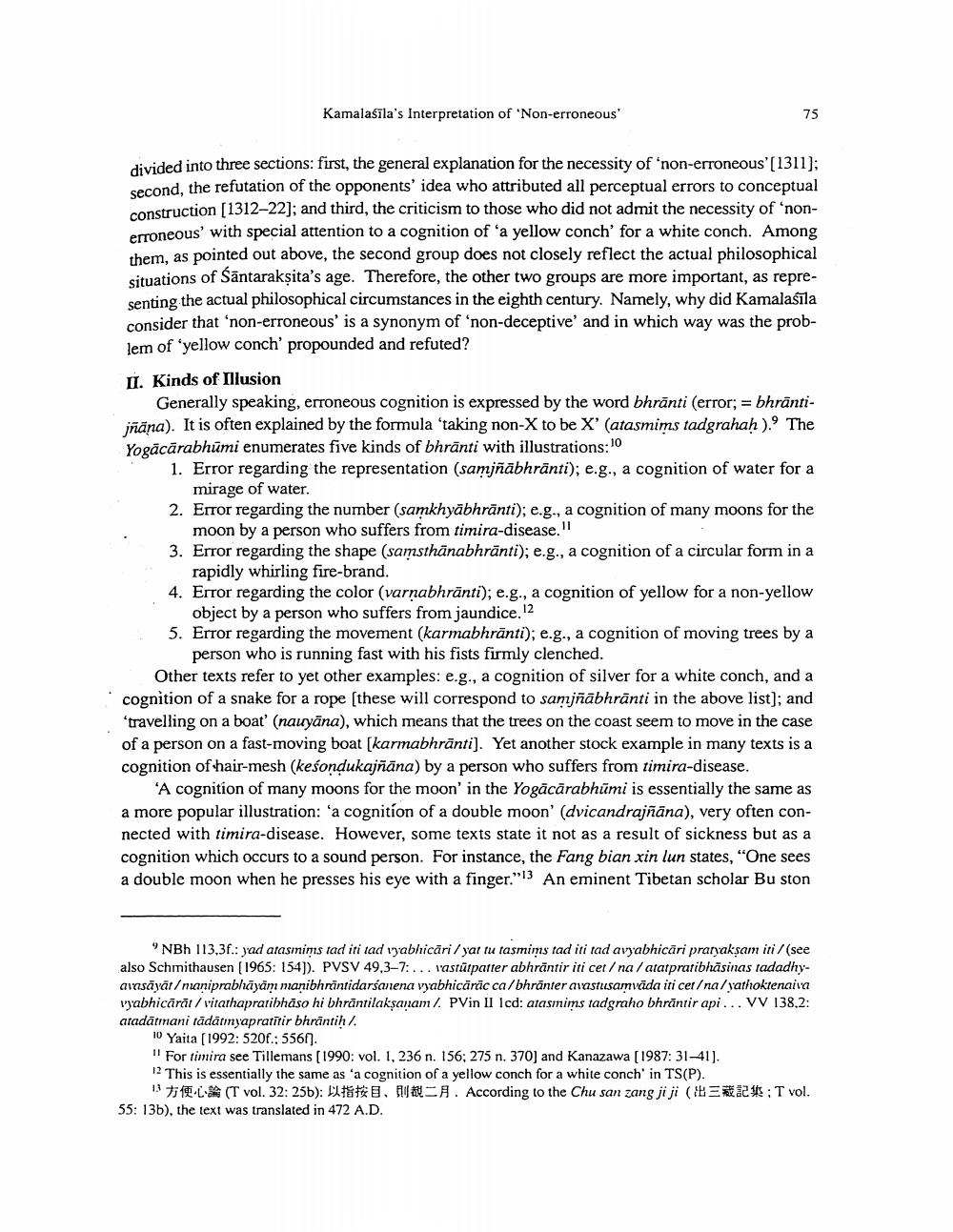________________
Kamalasīla's Interpretation of 'Non-erroneous'
divided into three sections: first, the general explanation for the necessity of non-erroneous' [ 1311); cecond, the refutation of the opponents' idea who attributed all perceptual errors to conceptual construction (1312-22]; and third, the criticism to those who did not admit the necessity of 'nonerroneous' with special attention to a cognition of 'a yellow conch' for a white conch. Among them, as pointed out above, the second group does not closely reflect the actual philosophical situations of Santarakṣita's age. Therefore, the other two groups are more important, as representing the actual philosophical circumstances in the eighth century. Namely, why did Kamalasīla consider that 'non-erroneous' is a synonym of 'non-deceptive' and in which way was the problem of yellow conch' propounded and refuted?
II. Kinds of Illusion
Generally speaking, erroneous cognition is expressed by the word bhrānti (error; = bhrāntijñāna). It is often explained by the formula 'taking non-X to be X' (atasmims tadgrahah). The Yogācārabhumi enumerates five kinds of bhrānti with illustrations: 10
1. Error regarding the representation (samjñābhrānti); e.g., a cognition of water for a
mirage of water. 2. Error regarding the number (samkhyābhrānti); e.g., a cognition of many moons for the
moon by a person who suffers from timira-disease." 3. Error regarding the shape (samsthānabhrānti); e.g., a cognition of a circular form in a
rapidly whirling fire-brand. 4. Error regarding the color (varnabhrānti); e.g., a cognition of yellow for a non-yellow
object by a person who suffers from jaundice. 12 5. Error regarding the movement (karmabhrānti); e.g., a cognition of moving trees by a
person who is running fast with his fists firmly clenched. Other texts refer to yet other examples: e.g., a cognition of silver for a white conch, and a cognition of a snake for a rope (these will correspond to samjñābhrānti in the above list); and 'travelling on a boat' (nauyana), which means that the trees on the coast seem to move in the case of a person on a fast-moving boat [karmabhrānti). Yet another stock example in many texts is a cognition of hair-mesh (kesondukajñāna) by a person who suffers from timira-disease.
'A cognition of many moons for the moon' in the Yogācārabhūmi is essentially the same as a more popular illustration: 'a cognition of a double moon' (dvicandrajñāna), very often connected with timira-disease. However, some texts state it not as a result of sickness but as a cognition which occurs to a sound person. For instance, the Fang bian xin lun states, “One sees a double moon when he presses his eye with a finger."3 An eminent Tibetan scholar Bu ston
"NBh 113.3f.: yad atasminis tad iti tad 1yablicări/yat tu tasmims tad iti tad avyabhicări pranyakşam iti / (see also Schmithausen (1965: 154]). PVSV 49,3–7:... l'astütpatter abhrāntir iti cet/na/atatpratibhāsinas tadadhyarasāyāt / naniprabhāyām manibhrantidarśanena vyabhicărac ca/bhranter avastusamvāda iti cet/na/yathoktenaiva vyabhicărāt / vitathapratibhāso hi bhrántilaksanam/. PVin II lcd: atasınims tadgraho bhrāntir api... VV 138.2: atadātmani tādātmyapratitir bhrantih/
10 Yaita (1992: 520f.: 556f). Il For timira see Tillemans (1990: vol. 1, 236 n. 156; 275 n. 370) and Kanazawa (1987: 31-41). 1? This is essentially the same as 'a cognition of a yellow conch for a white conch' in TS(P).
17 1. (T vol. 32: 25b): I. . According to the Chu san zang jiji ( F : T vol. 55: 13b), the text was translated in 472 A.D.




